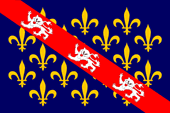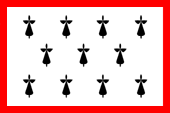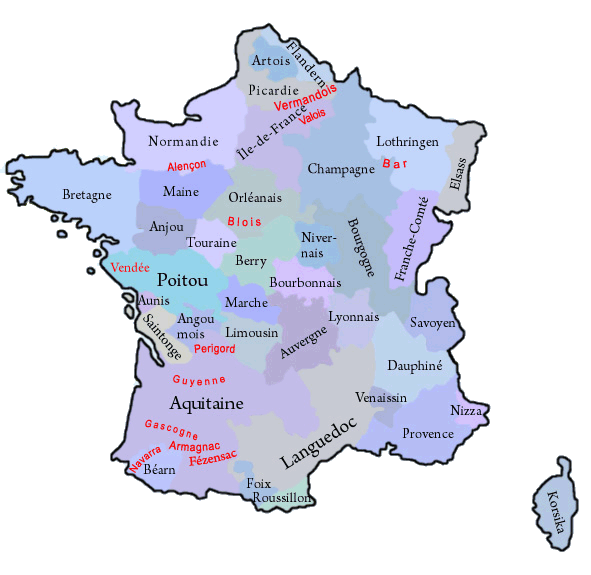mobile View, to the German Version tap the flag


- historical region in today's France
- former county, duchy and province
• Flag
• Meaning/Origin of the Flag
• Coat of Arms
• Meaning/Origin of the Coat of Arms
• Map of the historical Regions in France
• Explanations about the Regions
• History
• Origin of the Country's Name

Flag of Marche
– Drapeau de Marche,
Source, by: Wikipedia (FR)




1960–2016,
unofficial flag of Limousin
– Drapeau de officieux de Limousin,
Source, by: Wikipedia (D)






The flag of Marche shows the image of the coat of arms of the House of Bourbon-la Marche, which owned the county in the 14. century. The County of Marche was divided, the area is now mainly belonging to the Départements of Creuse and the north of Haute-ienne, and so between 1960 and 2016 to the region of "Limousin". The between 1960 and 2016 existing Region of "Limousin" used an unofficial flag. It showed a black ermine pattern on white (silver), with a red bordering outline, the heraldry of the ancient County of Limousin.
Source:
Volker Preuß,
Wikipedia (D)


958–1112, Périgord
Coat of arms of the House of Périgord
– Blason de la Maison du Périgord,
Source, by: Wikipedia (FR)

1200–1314, Lusignan
Coat of arms of the Lords of Lusignan
– Blason des Seigneurs de Lusignan,
Source, by: Wikipedia (FR)

1314–1322, Charles le Bel
Coat of arms of Charles the Fair
– Blason du Charles le Bel,
Source, by: Wikipedia (FR)

1322–1438, Bourbon-la-Marche
Coat of arms of the House of Bourbon-la-Marche
– blason de Maison du Bourbon-la-Marche,
Source, by: Wikipedia (FR)

1438–1477, Armagnac-Pardiac (Lomagne)
Coat of arms of the House of Armagnac-Pardiac
– blason de Maison du Armagnac-Pardiac,
Source, by: Wikipedia (FR)

1477–1525, Bourbon
Coat of arms of the Dukes of Bourbon
– Blason des Ducs d'Bourbon,
Source, by: Wikipedia (FR)

The heraldry of the County of Marche was quite variable and was associated with the heraldry of their rulers. None image of coat of arms achieved as a Heraldic feature that would have been taken over in the coats of arms of the successors in the rule over the county. That coat of arms, which is considered today as the coat of arms of Marche, is the coat of arms of the House of Bourbon-La Marche, who owned the county in the 14th century. The associated Heraldry showed the blue, with golden lilies topped shield of the Capetians, which was covered with a red oblique-right bar, and on it tree silvery leopards. The coat of arms of the Capetians showed three golden lilies on blue, but originally was the coat of arms sprinkled with lilies. From 1365 (by others sources 1376), the number of lilies was reduced to three. The lily-symbol is very old, already the Germanic tribe of the Franks has used it. The House of the Capetians has provided the kings of France between 987 and 1328. It goes back to Hugo Capet, son of Hugo the Great, who was electet to the King of France, in 987, after the death of King Ludwig V. from the House of the Carolingians. The Capetians brought out three branch lines which became the Kings of France: Valois 1328–1589, Bourbon 1589–1792 and 1814–1830, and Orléans 1830–1848.
Source:
Volker Preuß, Wikipedia (FR)

The historical, French Regions:

in black: governorate and province in 1776,
in red: former county, province oder governorate
Map: Volker Preuß

The until the French Revolution existing provinces (or governorates) have been historically grown structures, which had their roots oftenly in former fiefdoms of the French crown, historic counties and duchies. They oftenly existed for hundreds of years and had preserved regionality (e.g. cultural particularities and regional languages). On the occasion of the French Revolution such phenomena were of course not desirable, and as part of their bloody and violent egalitarianism any regional references were eliminated. Shortly after the French Revolution the provinces were dissolved and France became divided into many départements, which should have approximately the same size and the same status. The départements were named after rivers or mountains, to use never and in no circumstances the name of an old province. However, there was no success in cutting the connections of the people of France to their respective regions, so that administrative regions were re-created in 1960, to have a better control in regional administrative processes. In this way became départements, which were placed in a historical province, administratively grouped to an oftenly historically named region. The resulted structures coincide only approximately with the boundaries of the old provinces. In the strictly centralist France any regionality is avoided, so that even the official flags of these regions mostly look like flags of companies, unloving, unhistorical, technocratic and modernistic, and these flags should not be a subject of any lexical considerations here. Only in a few of that regions, exist official flags which remember the historical models. But, even the existence of these today's regions is douptful, because in 2014 was passed a territorial reform valid from the year 2016, that reduces the number of the existing regions by merging to nearly the half. However, there exist unofficial flags in nearly all of these regions, which should remember the old provinces and the old heraldry.
Wikipedia Link to the regions of France:
click or tap here
FOTW Link to the regions of France:
click or tap here
Source: Flags of the World,
Wikipedia (D),
Volker Preuß

antiquity · settlement by Celtic tribes
52 B.C. · Roman conquest, forming of the province of Aquitania in the west of Gaul
418 A.D. · the Visigoths be settled as federates
5th century A.D. · conquest of Gaul by the Franks (under King Clovis) to 507 conquest of Aquitaine, expansion of the empire to the Atlantic Ocean, the Pyrenees and the Alps
ca. 550 · administrative division of the empire into the kingdoms of Austrasia and Neustria, and the Duchy of Aquitaine and the Kingdom of Burgundy
639 · death of King Dagobert I., the power goes over to the Mayors of the Palace (maior domus) of Austrasia (House of the Carolingians)
687 · Pepin II. asserts itself as Mayor of the Palace throughout the Frankish Empire
8th century · fights between the Dukes of Aquitania and the Frankish kings
751 · Pepin the Short (III., grandson of Pepin II.) eliminates the Merovingian monarchy and let hisself elect to the king from the Franks
771 · Charlemagne takes over Aquitaine and transmits it later as a kingdom to his youngest son Louis the Pious
814 · Louis the Pious hands over Aquitaine (and the Spanish March) to his son Pippin
843 · division of the Frankish Empire (Treaty of Verdun), there arise the West Frankish Kingdom of Charles II. (the Bald), the Middle Frankish Kingdom of Lothar (Lotharingia), and the East Frankish Kingdom of Louis II., Aquitaine comes to the Empire of Charles the Bald
855 · Charles the Bald lets elect his son Charles to the King of Aquitaine
867 · Death of King Charles, he is succeeded by his brother Louis (Louis the Stammerer)
870 · at the division of the Frankish Empire (Treaty of Meersen) arises the West Frankish Kingdom, the East Frankish Kingdom, and the Frankish Kingdom of Italy
877 · Ludwig ascends the West Frankish throne, Aquitaine is given as a fief and a duchy to Rainulf, Count of Poitiers (House of the Ramnulfids)
880 · by the division of the Frankish Empire (Treaties of Verdun and Ribbemont) arises the West Frankish Kingdom (later France), the East Frankish Kingdom (later German Empire), the Kingdom of Italy, the Kingdom of Upper Burgundy (under Rudolf the Welf) and the Kingdom of Lower Burgundy persists
898 · Odo, Count of Paris and Duke of Francia, is elected to the king of the East Frankish Empire, Rainulf takes over the title of the King of Aquitaine
909 · Aquitaine is a duchy again, under William the Pious (Williamids, Gellones)
927 · Aquitaine comes to the House of Poitou (Ramnulfids)
944 · William III., Duke of Aquitaine, establishes the County of Marche and gives it as a fiefdom to Boso I., Count of Périgord, Limoges and Charroux
950 · Aquitaine includes now the counties of Gascony, Armagnac, Fézensac, Périgord, Poitou, Angoulême and La Marche
987 · death of the childless West Frankish King Louis V. (House of Carolingians), his heir and uncle Charles of Lower Lorraine could not prevail, the nobility elects Hugh Capet (House of Capet) to the king, the Capetians are the Kings of France to 1328
1112 · County of Marche comes as heritage to Roger of Montgomery, who is merried with Almodis, doughter of Aldebert II. from the House of Périgord
1152 · Henry Plantagenet marries Duchess Eleanor of Aquitaine, the duchies of Aquitaine and Gascony come to the house of Anjou-Plantagenet
1154 · death of Stephen of Blois (King of England) , Henry is his successor as Henry II., Anjou becomes in this way a fief of the French king, which is a part of the crown of England (House of Anjou-Plantagenet)
1177 · Aldebert IV. of Montgomery sells Marche to Henry II. of Plantagenet
1220 · Isabella, daughter of Aymar Taillefer, merrys as second wife Hugo X. of Lusignan, the County of Angoumois comes in this way the House of Lusignan
1200 · Hugh I., Lord of Lusignan, descendant of Count Bernard I. of Montgomery marries Mathilde of Angoulême, in this way the House of Lusignan takes over (probably as a dowry) the County of Marche
1204 · Philip Augustus, King of France, conquers Normandy, Anjou, Maine and Touraine (Angevin Empire of the Plantagenets)
1224 · King Louis VIII. of France, son of Philip Augustus, conquers Aquitaine, except Gascony the last possession of the Plantagenets in France, Poitou and Saintonge come directly to the crown, La Marche, Périgord, Angoulême and Auvergne become fiefs
1309 · Marche bekomes temporary a Duchy
1314 · death of Jolanda I. (Mistress of Lusignan, last of the House of Lusignan in Marche), Philipp IV., King of France, retracts Marche as a completed fief and passes it as an appanage to his younger son Charles the Fair
1322 · Charles the Fair becomes King of France as Charles IV., the Duchy of Marche becomes in this way part of the royal domain
1327 · Charles IV. exchanges Marche against the County of Clermont-en-Beauvaisis, Louis de Bourbon (from a line of the Capetians) becomes Duke of Marche
1328 · death of King Charles IV. (the Fair), extinction of the direct Capetian line, according to Salic Law Count Philip of Valois (Son of Prince Charles of Valois, first cousin of King Charles IV.) came on the French throne (as King Philip VI .), the English king Edward III. lays claim to the throne as a maternal nephew of Charles IV., reason for the "Hundred Years War" (Anglo-French War, 1338–1453), out of the House of Valois came all kings of France from 1328 to 1589
1438 · Bernard d'Armagnac (out of the House of Lomagne), Count of Pardiac and La Marche, Duke of Nemours, inherits after the death of James II. of Bourbon the Duchy of Marche, because he is married to his daughter Éléonore of Bourbon
1453 · Battle of Castillon, the end of the Hundred Years War, the Kings of England have to cede all their possessions in France
1477 · Jacques d'Armagnac (out of the House of Lomagne), Count of Pardiac and La Marche, Duke of Nemours, is convicted of high treason, his property is confiscated by King Louis XI., he gives Marche as a fief to his son-in-law Pierre II. of Beaujeu (House of Bourbon-Beaujeu)
1503 · Marche comes as an inheritance to the House of Bourbon-Montpensier
1525 · Francis I., King of France, outlaws Duke Charles of Bourbon, his property is confiscated by the king
1531 · Marche becomes part of the royal domain
1776 · the already in the 14th century created governorates of the civil administration of the kingdom of France become committed to a number of 39, and correspond in this way to the number of provinces, in previous years could any provinces be summarized in one governorate
1789 · French Revolution, the governorates and provinces become abolished, Marche is divided in départements (the east of the province comes mainly to Creuse, the west to the north of Haute-Vienne, small parts come to Charente, Vienne and Indre)
1960 · reintroduction of regions in France, the Marche doesn't play a role, affiliation with the newly created Limousin region (capital Limoges), of course not within the historic boundaries, just by integrating of the departments of Corrèze, Creuse and Haute-Vienne
2016 · the Limousin region merges with the Poitou-Charentes and Aquitaine regions in the new, larger region of New Aquitaine (Nouvelle-Aquitaine)
Source:
Wikipedia (FR),
Meyers Konversationslexikon,
Taschenatlas Weltgeschichte

The name "Marche" means "hard walk" and recalls that this area was placed between the possessions of the old rivals, the Counts of Poitou (Dukes of Aquitaine) and the kings of France, which was to pass through – probably as a kind of "wilderness" or at least "neutral territory" – as quickly as possible.
Source:
Wikipedia (FR),
Volker Preuß


![]()













